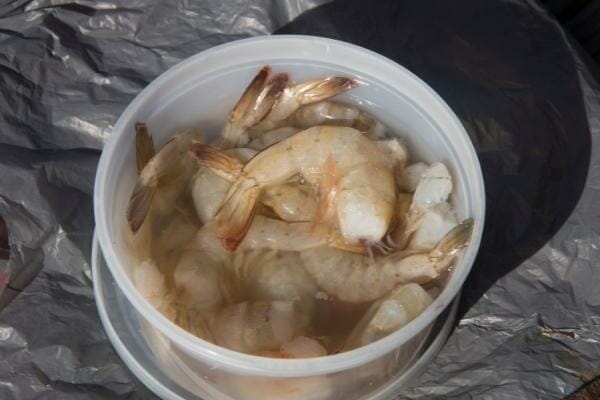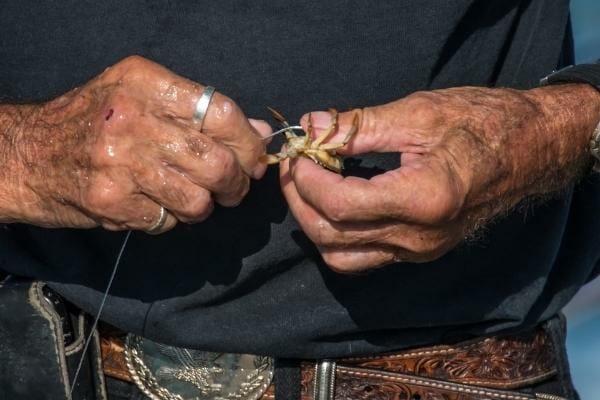Saltwater fishing is widely considered to be one of the most exciting forms of angling in the world. This is mainly due to the fact that saltwater fishing involves a huge variety of different species of game fish that range from small to very large.
Many of the fish that roam the seas and coastal areas are highly-adapted predators that are built for seeking out the most nutritious meals they can find swimming in the ocean.
Anglers who regularly fish in the ocean and along coastal areas must be well-acquainted with the types of baits that saltwater fish tend to prefer, depending on which species you’re going after and at what time of year.
Understanding just what type of bait your chosen fish species will be attracted to is part of what makes someone what most people would consider an expert angler.
In this article, we will cover the 5 best saltwater fishing baits and how each angler should use them, as well as the different reasons why one might choose one type of bait over another.
Best Bait for Saltwater Fishing
1. Squid

The best saltwater bait for beginners, in the opinion of most expert anglers, is squid.
This is mainly due to the fact that squid have an especially oily nature and their flesh is exceptionally tough, which means they will stay on the hook better and longer than just about anything else.
These are usually available at any bait shop and are also relatively cheap. There really is no wrong way to hook a piece of squid and these are usually best for fishing on bottom or trolling.
Using squid in an excellent approach to fishing for just about anything in the ocean as the smell produced by the squid’s oil is generally irresistible to most types of fish that can be found along the coastal areas and underwater reefs.
If you plan to use squid for saltwater bait, be sure to cut it up into the particular size you want to use. If you’re hoping to catch smaller fish species, cut the squid into very smaller pieces.
2. Shrimp

Shrimp is arguably the top saltwater fishing bait available in the world. These small critters can be found in great numbers at your local bait shop and are typically available in frozen blocks, or live buckets.
Shrimp are usually considered the best baits for fishing inlets and around docks or piers as they will be quickly recognized by hungry game fish species as an easy meal.
There are a variety of different shrimp baits that can be used, as well as different sizes of live shrimp. It’s best to use the size that you feel gives you the best chance of catching the type of fish you’re after.
One of the main downsides to fishing with shrimp is that they are notoriously soft-bodied and can be easily ripped off the rig if they aren’t hooked properly.
The best method for hooking shrimp is to run the hook through starting at their top portion close to the head and curve the shrimp along with the curvature of the hook before pulling the hook out at the base of the back.
This will prevent smaller types of fish from picking away at the shrimp and quickly leaving you with a bare hook in the water.
3. Crabs

When it comes to going after larger predators and game fish in the ocean, crabs are usually an excellent choice of bait.
Crab are excellent bait for tarpon and other large-sized fish that can be found in coastal waters, but it can be hard to find crabs that are suitable for bait. Anything from soft-shell, hard-shell, or peeler crabs make good bait for fishing in deeper water around the coast.
The main problem with fishing for crab is that they aren’t as readily available as other types of saltwater bait.
The best way to keep a steady supply of crab for fishing is to regularly use a crab trap and catch them shortly before you plan to fish.
Hooking crab present another problem, but most anglers prefer to bore the hook through the shell of the crab so as not to lose it to any fish that happens to bite.
4. Cut Bait

When it comes to appealing to a sportfish’s senses, there are few baits that are better-suited to do so than cut bait.
The term cut bait can entail a variety of different bait fish species such as menhaden, variations of shad, skipjack herring, and many other types of fish.
Most bait shops will carry these in limited supplies as they must be caught by various commercial fishing vessels and brought in to sell.
Some bait shops sell fresh cut bait, but most seasoned anglers prefer to use cut bait that has been salted and cured as this kind will generally stay on the hook for longer periods.
Hooking cut bait isn’t terribly difficult as most anglers simply run the hook through the skin and flesh and let the rest of the cut bait dangle below the hook to attract fish.
Cut bait is an excellent choice for catching many different types of popular game fish like snapper, grouper, mackerel and many other types of saltwater species.
5. Sand Fleas

One of the most underrated saltwater baits in the world are the common sand flea. These are mostly used for surf fishing as any fish prowling the coastline will not think twice about biting a sand flea that’s above the surface and exposed in the water.
Sand fleas are not sold in bait shops and must be caught by the angler themselves in most cases.
If you’re fishing with kids, the process of finding and catching sand fleas can be a fun activity in and of itself. Once you’ve caught a decent amount, be sure to keep them secure in a large bucket so they don’t get out and burrow back down into the sand.
You can usually hook sand fleas through their hardened shell portion near the head, or from the back end with the hook running up through the shell.
Either way, you’ll want to be sure that these kinds of bait are securely hooked because they typically require a bit of patience and know-how to catch and use properly.

